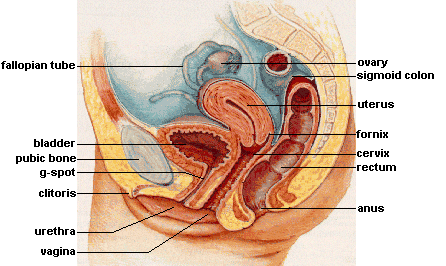Overview of female reproductive system
The female reproductive system is made up of the external genital organs, two ovaries, two uterine tubes, a uterus and a vagina.

These consist of the labia majora, labia minora, clitoris and the mons pubis.
Labia Majora and Labia Minora
The labia majora is the outer most part of the genital organs, and provides protection for the other external structures. It is fatty skin that extends from the mons pubis, and is covered in hair in adult females. It serves the same function as the scrotum in males.
The labia minora are smaller lips of skin that are found between the labia majora. They split to surround the openings of the vagina and the urethra, as well as enclosing the clitoris.
Clitoris
The clitoris is basically the female penis. It is divided into the root, body and glans. The root consists of erectile tissue, divided into three parts: the bulb of the vestibule and left and right crura. The bulb is like the bulb of the penis, but it is divided in two because of the vagina.
The two corpora cavernosa, derived from the crura, make up the body, and a small amount of erectile tissue that lies over it make up the glans of the clitoris.
Mons Pubis
This is the skin at the front of the pubis, which is covered in hair in adult females.
Internal Genital Organs
Ovaries
The ovaries are small oval shaped structures that lie at the end of the uterine tubes. They are connected to the uterus by the round ligament, and to the wall of the pelvis by the suspensory ligament of the ovary. The female gametes, the ova, are produced in the ovaries. They are also involved in the production of the female hormones oestrogen and progesterone.
Uterine Tubes
These are small tubes that connect to the uterus, and allow the transport of ova from the ovaries into the uterus. They divide into four parts, the infundibulum, ampulla, isthmus, and intramural parts. The infundibulum overlies the ovaries and has finger-like projections, fimbriae, which waft the ovum towards them. The ampulla provides the site for normal fertilisation of the egg by sperm, and is the widest part of the tube. The part of the tube that lies just lateral to the uterus is the isthmus. This is the narrowest part. The intramural part joins the tubes to the uterus wall.
Uterus
This is pear-shaped and hollow, and where the development of the fetus occurs. It is split into the fundus, body and cervix, with a hollow centre in the middle. The fundus lies above the cavity; the body is the central part surrounding the cavity, which then narrows to form the cervix. The cervix leads in to the vagina. The internal os connects the cervix with the cavity of the uterus, and the external os connects the cervix to the vagina. During menstruation, the lining of the cavity of the uterus, the endometrium, falls away resulting in bleeding.
Vagina
The vagina is a muscular tube that connects the cervix to the external organs. It is also called the birth canal, as this is the route used when the baby is being born.
The female reproductive system has several functions. It produces the female gametes, called oocytes or ova. It transports the ova to the place of fertilisation by sperm, which usually occurs in the uterine tubes. The fertilised ovum is then transported to the uterus, where it implants in to the wall, initiating the first stages of pregnancy. If the ovum is not fertilised, or it does not implant into the wall, the lining of the uterus, the endometrium, breaks down resulting in menstruation. The reproductive system is also involved in the production and secretion of female sex hormones.
Internal Female Reproductive System Image courtesy of wikimedia under the creative commons license https://upload.wikimedia.org/wikipedia/commons/7/7a/Female_reproductive_system_lateral.png
